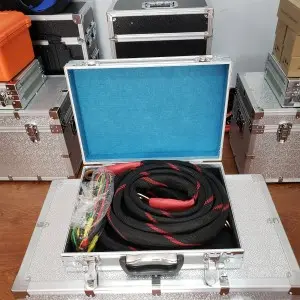In the field of electrical engineering and power systems, various equipment and instruments play crucial roles in ensuring accurate measurements, efficient testing, and reliable power monitoring. Three such instruments are Fischer Karl Titrators, Hipot VLF Testers, and Energy Meter Power analyzers. Understanding the capabilities and features of Fischer Karl Titrators, Hipot VLF Testers, and Energy Meter Power analyzers will enable professionals and industry stakeholders to make informed decisions and optimize their operations for enhanced performance, safety, and power management.
Fischer Karl Titrators: Precise Analysis of Chemical Substances

Fischer karl titrated titrators are widely used in laboratories and industrial settings for quantitative chemical analysis. Here are the key features and applications of Fischer Karl Titrators:
a. Titrations: Fischer Karl Titrators employ the principle of titration to determine the concentration of a chemical substance in a sample. This involves measuring the volume of a reagent required to react completely with the analyte.
b. Versatility: These titrators are suitable for various titration methods, including acid-base, redox, complexometric, and precipitation titrations. They offer flexibility in selecting the appropriate method based on the specific analysis requirements.
c. Precision and Accuracy: Fischer Karl Titrators provide precise and accurate results, ensuring reliable measurements for quality control, research, and development purposes.
d. Automation and Ease of Use: Many modern Fischer Karl Titrators offer automated features, including precise reagent dispensing, endpoint detection, and result calculation. This simplifies the titration process, reduces human errors, and improves efficiency.
e. Applications: Fischer Karl Titrators find applications in pharmaceuticals, chemical industries, environmental analysis, food and beverage production, and research laboratories, where precise quantification of chemical substances is essential.
Hipot VLF Testers: Ensuring Safety in High-Voltage Systems
Tester hipot vlf, also known as High Potential Very Low Frequency Testers, are crucial instruments used for testing and evaluating the insulation strength of high-voltage equipment. Here are the key features and applications of Hipot VLF Testers:
a. Insulation Testing: Hipot VLF Testers generate high-voltage, very low frequency (VLF) signals to test the insulation integrity of cables, transformers, motors, and other electrical apparatus. This helps identify potential insulation weaknesses, such as insulation breakdown or partial discharge.
b. VLF Technology: VLF signals, typically in the range of 0.1 Hz to 0.01 Hz, offer several advantages for insulation testing. They stress the insulation system more uniformly and are capable of detecting insulation defects that might go unnoticed with other testing methods.
c. Safety and Compliance: Hipot VLF Testers ensure the safety of high-voltage systems by identifying insulation weaknesses before they lead to catastrophic failures or accidents. These testers also enable compliance with international standards and regulations for insulation testing.
d. Portable and User-Friendly: Many Hipot VLF Testers are designed to be portable and user-friendly, allowing for easy transportation and operation in field testing applications.
e. Applications: Hipot VLF Testers are widely used in power utilities, electrical maintenance and testing companies, manufacturing industries, and research institutions to assess the condition of high-voltage equipment and ensure the safety and reliability of power systems.
Energy Meter Power Analyzers: Efficient Monitoring and Analysis
Energy Meter Power Analyzers are essential instruments used for monitoring, analyzing, and optimizing power consumption in electrical systems. Here are the key features and applications of Energy Meter Power Analyzers:
a. Power Measurement: Energy Meter Power Analyzers accurately measure various electrical parameters, including voltage, current, power factor, active power, reactive power, and harmonic distortions. This enables comprehensive monitoring and analysis of power consumption.
b. Energy Efficiency: These analyzers help identify energy consumption patterns, inefficiencies, and areas for improvement, allowing for energy-saving measures and cost reduction.
c. Power Quality Analysis: Energy Meter Power Analyzers assess power quality issues, such as voltage sags, surges, harmonics, and flicker. This helps diagnose and mitigate power quality problems that can affect equipment performance and reliability.
d. Data Logging and Reporting: Many Energy Meter Power Analyzers offer data logging capabilities, allowing for long-term monitoring and data analysis. They also generate detailed reports for energy audits, compliance, and performance evaluation.
e. Applications: Energy Meter Power Analyzers are utilized in commercial buildings, industrial facilities, data centers, renewable energy systems, and utility substations to monitor energy consumption, optimize power usage, and ensure compliance with energy regulations.